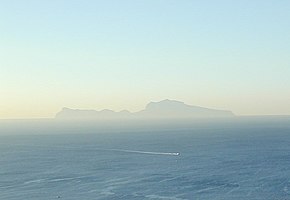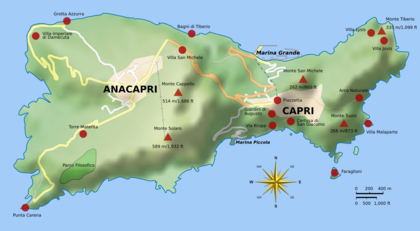Difference between revisions of "Capri"
m |
m |
||
| Line 6: | Line 6: | ||
!colspan=2 style="color: white; background: darkred;"|'''Comune di Capri''' | !colspan=2 style="color: white; background: darkred;"|'''Comune di Capri''' | ||
|- | |- | ||
| − | |Region || [[Campania]] | + | |Region || [[Campania]] |
|- | |- | ||
| − | |Province || [[Province of Naples|Naples]] (NA) | + | |Province || [[Province of Naples|Naples]] (NA) |
|- | |- | ||
| − | |Altitude | + | |Altitude || |
|- | |- | ||
| − | |Area cityproper || 3 | + | |Area cityproper || 3 |
|- | |- | ||
| − | |Population as of || [[December 31]], [[2004]] | + | |Population as of || [[December 31]], [[2004]] |
|- | |- | ||
| − | |Population density || 7,278 | + | |Population density || 7,278 |
|- | |- | ||
| − | |Population density metric || 2,353 | + | |Population density metric || 2,353 |
|- | |- | ||
|Timezone || [[Central European Time|CET]], [[Coordinated Universal Time|UTC]]+1 | | |Timezone || [[Central European Time|CET]], [[Coordinated Universal Time|UTC]]+1 | | ||
Revision as of 21:44, 3 November 2007
| Comune di Capri | |
|---|---|
| Region | Campania |
| Province | Naples (NA) |
| Altitude | |
| Area cityproper | 3 |
| Population as of | December 31, 2004 |
| Population density | 7,278 |
| Population density metric | 2,353 |
| Timezone | CET, UTC+1 | |
| Frazioni | |
| Telephone | |
| Postalcode | |
| Gentilic | |
| Saint | St. Constantius of Aquino| |
| Day | May 14 | |
| Mayor | |
| Website | |

Capri (Italian pronunciation Cápri, usual English pronunciation Caprí) is an Italian island off the Sorrentine Peninsula. On the south side of the Gulf of Naples, it has been a celebrated beauty spot and resort since the time of the Roman Republic. The features are a litany of postcard views: the Marina Piccola (Small Harbor), the Belvedere of Tragara, which is a high panoramic promenade lined with villas, the limestone masses that stand out of the sea (the 'Faraglioni'), Anacapri, the Blue Grotto ('Grotta Azzurra'). Above all are the ruins of the Imperial Roman villas.
Capri is in the region of Campania, Province of Naples. The City of Capri is the main centre of population on Capri. It has two adjoining harbours, Marina Piccola and Marina Grande (the main port of the island).
The separate commune of Anacapri is located high on the hills west from the city of Capri.
History
Ancient and Roman times
According to the Greek geographer Strabo, Capri was once united to the mainland. This has been recently confirmed both by geological surveys and archaeological findings.
The city was inhabited since very early times. The first findings of human settlement were already discovered during Roman age. According to Suetonius, when the foundations for the villa of Augustus were being excavated, giant bones and 'weapons of stone' were discovered, which the emperor ordered to be displayed in the garden of his main residence, the Sea Palace, one of the first displays of fossils. More modern excavation s have showed that human presence on the island can be dated back to the Neolithic and the Bronze Age.
In his Aeneid, Virgil states that the island had been populated by the Greek people of Teleboi, coming from the Ionian Islands. Strabo says that "in ancient times in Capri there were two towns, later reduced to one." (Geography, 5, 4, 9, 38). Tacitus records that there were twelve Imperial villas in Capri (or Capreae, as it was spelled in Latin). Ruins of one at Tragara could still be seen in the 19th Century.
Augustus's successor Tiberius also built a series of villas at Capri, the most famous of which is the Villa Jovis, one of the best preserved Roman villas in Italy. In 27, Tiberius permanently moved to Capri, running the Empire from there until his death in 37. According to Suetonius, while staying on the island, Tiberius (accompanied by his grand-nephew and heir, Caligula) enjoyed performing numerous cruelties and sexual perversions upon their slaves. However, many of these alleged cruelties may be the result of negative propaganda by the Senate party or by the Church itself, which had an interest to defame Tiberius, who had persecuted early christians.
In 182, Emperor Commodus banished his sister Lucilla to Capri. She was executed shortly afterwards.
Middle and Modern Ages
After the end of the Western Roman Empire, Capri returned to be a dominion of Naples, and suffered for various attacks and ravages by pirates. In 866 Emperor Louis II gave the island to Amalfi. In 987 the first Caprese bishop was consecrated by Pope John XV.
In 1496 a diplom by Frederick IV of Naples established legal and administrative parity between the two settlements of Capri and Anacapri. The pirate raids reached their peak during the reign of Charles V: the famous Turkish admirals Khair ad-Din and Dragut sacked the island in 1535 and 1553, respectively.
The first famous visitor of the island was the French Jean Jacques Bourchard, in the 17th century. His diary, found in 1850, is an important source about the state of Capri in that age.
Recent history
In January 1806, French troops occupied the island. The British ousted the French troops in May of the same year. Capri was turned into a powerful naval base (a "Second Gibralter"), but the building program caused heavy damage to the archaeological sites. Joachim Murat conquered back Capri in 1808, and the French remained there until the end of the Napoleonic era (1815), when Capri was returned to the Bourbon ruling house of Naples.
In the 2nd half of the 19th century, Capri became a popular resort for european artists, writers and other celebrities. John Singer Sargent and Frank Hyde are among the prominent artist who stayed on the island around the late 1870s. Sargent is best known for his series of portraits featuring the most beautiful Capri model, Rosina Ferrara. An own villa or a stay of more than three months is reported for: Norman Douglas, Friedrich Alfred Krupp, Christian Wilhelm Allers, Emil von Behring, Curzio Malaparte, Axel Munthe, Maxim Gorky. Gracie Fields also had a villa on the Island and sang two songs, "The Isle of Capri" and "Come Back to Sorrento" about Capri. When she died on the island in 1978, she left her villa to female impersonator, Danny La Rue who reportedly spends most of the year in Capri when he isn't in a production.
Capri in literature
The book that spawned the 19th century fascination with Capri in France, Germany, and England was Entdeckung der Blauen Grotte auf der Insel Capri by the German painter and writer August Kopisch, in which he describes his 1826 stay on Capri and his (re)discovery of the Blue Grotto.
Capri is also the setting for "The Lotus Eater", a short-story by Somerset Maugham. In the story, the protagonist from Boston comes to Capri on a holiday and is so enchanted by the place he gives up his job and decides to spend the rest of his life in leisure at Capri.
Claude Debussy refers to the island's hills in the title of his impressionistic prélude Les collines d'Anacapri (1910).
Jacques d'Adelsward-Fersen wrote the roman à clef Et le feu s’èteignit sur le mer (1910) about Capri and its residents in the early 20th century, causing a minor scandal. Fersen's life on Capri the subject of Roger Peyrefitte's fictionalised biography, L'Exile de Capri. Norman Douglas's novel South Wind is set in Capri and many of its residents and visitors are only thinly disguised. Douglas also wrote a number of other books and pamphlets on Capri incuding Capri (1930) and his last work, A Footnote on Capri (1952). Douglas, Fersen, the 19th century poet August Graf von Platen, and other writers were attracted to Capri by the opportunity to carry out their homosexual life-styles. A satirical presentation of the island's lesbian colony in the 1920s is made by Compton Mackenzie's novel Extraordinary Women (1928).
Edwin Cerio's book Aria di Capri (1928) (later translated as That Capri Air) contains a number of historical and biographical essays on the island, including a tribute to Norman Douglas.
The writer and Swedish royal physician Axel Munthe (1857–1949) built the Villa San Michele near Anacapri. His memoirs, The Story of San Michele were published in 1929.
Shirley Hazzard wrote the memoir Graham on Capri: A Memoir (2000) about her reminiscences of Graham Greene and Capri. Greene was also a friend of Norman Douglas in the latter's last years, and edited (and perhaps extensively rewrote) the memoirs of Elisabeth Moor, who worked as a doctor on Capri from 1926 until the 1970s (An Impossible Woman:The Memoirs of Dottoressa Moor (1975)).
Main sights
- Villa San Michele
- Grotta Azzurra, the Blue Grotto
- Villa Lysis
- Villa Jovis
- La Piazzetta
- Via Krupp
- Arco Naturale
- Villa Malaparte
- Torre Materita
- Certosa di San Giacomo
- Faraglioni
- Monte Solaro
- Punta Carena
Tourism
Capri is a tourist destination for both Italians and foreigners. In the 1950s, Capri became a popular destination for the international jet set. The central piazzetta of Capri, though preserving its modest village architecture, is lined with luxury boutiques, expensive restaurants, and paparazzi chasing celebrities.
During summers, the island is heavily touristed, often by day trippers from Naples and Sorrento. To savour the wonderful light and atmosphere of the island it is best to be out and about early in the morning and late in the day and out of the high season.
Transportation
Capri is served by frequent ferry and hydrofoil service to Naples and Sorrento, as well as many other boat services to the ports of the Gulf of Naples and the Sorrentine Peninsula.
See also
External links
- Movie - Contempt aka Le Mepris
- Capri Attractions and Practical Tips
- Capri Hotels and Accommodation in Isle of Capri Italy
- Capriweb illustrated highly informative tourist itineraries.
- Island of Capri - Information for tourists
- Capri Hotels near the Piazzetta
- ItalianVisits.com
- Capri Guide
- Capri Apartments and luxury Villa rentals


